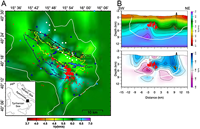A detailed analysis of wastewater‐induced seismicity in the Val d’Agri oil field (Italy)
Improta L., L. Valoroso, D. Piccinini, C. Chiarabba (2015).
Geophysical Research Letters, Volume 42, Issue 8, Pages 2682–2690, doi:1002/2015GL063369.
Abstract
The Val d’Agri basin in the Apennines seismic belt hosts the largest oil field in onshore Europe. High-quality recordings from a temporary dense network unravel a swarm of 111 small-magnitude events (ML ≤ 1.8) occurred in June 2006 during the first stage of wastewater injection into a high-rate well. High-precision relative locations define a preexisting blind fault located 1 km below the well inside fractured and saturated carbonates where wastewater is reinjected. Seismicity begins 3 h after the initiation of injection. The seismicity rate strictly correlates with injection curves and temporal variations of elastic and anisotropic parameters. Seismicity is induced by rapid communication of pore pressure perturbations along a high-permeability fault zone favorably oriented with respect to the local extensional stress field. Our accurate 3-D locations of 219 events (ML ≤ 2.2) detected by the local operator network after June 2006 concentrate on the preexisting fault measuring 5 km along dip. Over the following 7.5 years, the seismicity rate correlates with short-term increases in injection pressure.
http://onlinelibrary.wiley.com/doi/10.1002/2015GL063369/full


